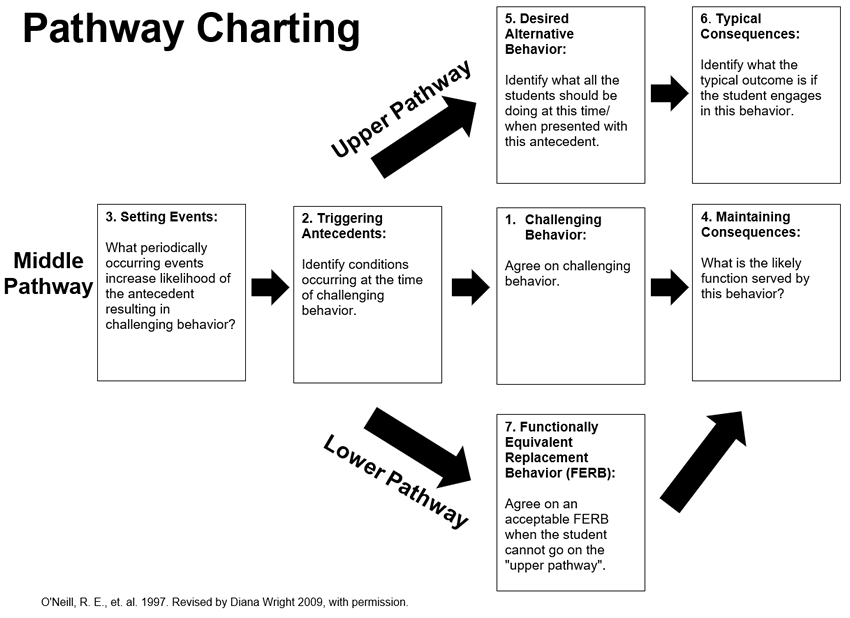Pathway Charting
What is a Three Pathway Summary Chart?
All functional behavioral assessments examine the predictors for current challenging behavior (immediate and past antecedents to the behavior) to determine what is supporting the challenging behavior as well as the maintaining consequence (function) of the behavior. The Pathway Chart summarizes those findings graphically, also visually depicting the differnet Pathways the student may go on when faced with the triggering antecedent (Upper Pathway: desired behavior, Middle Pathway: challenging behavior, Lower Pathway, Acceptable Alternative/Replacement Behavior).
If the lead behavior consultant collaboratively structures the team in graphing the pathways in the following order, the team will gain an understanding of the foundation of the subsequent behavior plan. It helps to build understanding and buy-in, both important elements for implementation of the interventions outlined in the plan.
Each step corresponds to one of the boxes on the Pathway Chart, the corresponding box is labeled with the step number, as depicted in the image below.

Steps in Pathway Charting
Step One - Identify the Challenging Behavior:
Begin by agreeing on the challenging behavior definition.
Rationale: The team must agree on the challenging behavior to graph and address in the plan. This is the logical beginning.
Step Two - Identify Triggering Antecedents:
Discuss the predictors, triggering antecedents, that occur preceding the challenging behavior. Your environmental analysis will have pointed out variables that support challenging behavior, (e.g., lengthy wait times, task complexity and skill mismatches, etc.)
Rationale: Identifying these antecedents allows the team to come to consensus and understand what triggers the challenging behavior. This must be understood to effectively intervene.
Step Three - Identifying the Setting Event(s):
Sometimes, but not always, setting events strengthen the likelihood that the student is especially likely to use challenging behavior when confronted by the triggering antecedents (e.g., lack of sleep, late bus, illness, hunger, etc.)
The team may have data to contribute in this section. The behavior plan will address altering the environment, task, or instruction when the setting event occurs to reduce the likelihood of challenging behavior.
It is important to note that not all students will have known setting events and this box may be left blank.
Rationale: Identification of setting events allows the team to understand what factors may occasionally occur and that should be watched for. This helps increase the understanding that on some days, the student will need additional support and/or accommodations to be successful.
Step Four - Identifying the Maintaining Consequences:
The FBA should have identified the maintaining consequences of the challenging behavior, (i.e., the function, the communicative intent, what the student is getting, or rejecting (avoiding, accessing) by using the challenging behavior.)
Rationale: The team must have a consensus understanding of the purpose of the behavior before developing the functionally equivalent behavior. If there is disagreement, it decreases the likelihood that the team will implement the use of the FERB.
Step Five - Identifying the Desired Alternative:
The desired alternative behavior is the general positive behavior expected of all students when faced with the triggering antecedent (e.g., if the triggering antecedent is being given a math worksheet, the desired behavior would be for the student to complete the worksheet.)
Typically, the teacher will be able to easily provide this statement.
Rationale: Discussing the desired alternative behavior helps the team grasp that the eventual goal is to get the student onto this upper pathway and demonstrating the behavior their peers do when faced with the triggering antecedent.
This step, while often overlooked when behavior planning, is incredibly important, as it helps build buy-in and understanding.
Step Six - Identify the Typical Consequence:
The team now discusses the typical outcome/consequence of the general positive behavior.
What happens when students typically do this behavior? Why would it be desirable for the student to use this behavior? Typically, the teacher will readily provide this information.
Rationale: Identifying this typical consequence can help understand if there are additional supports needed to support the student in demonstrating this desired alternative. For example, if the typical consequence of completing a worksheet is to be given another worksheet, the team may identify that the student needs additional reinforcement for completing the work before getting the next worksheet.
This step, while often overlooked when behavior planning, is important as it helps the team identify what individualized needs the student may require to support demonstration of positive behavior. Additionally, it can help the teacher understand that there may be small things that can be changed to reduce challenging behavior.
Step Seven - Identify the Functionally Equivalent Replacement Behavior (FERB):
What functionally equivalent replacement behavior will be selected for the student?
This is often the most difficult element of function-based behavior analysis for most teams.
The consultant will likely need to point out that for some students, this is only a temporary step until such changes to support the upper pathway are systematically addressed. However, for other more complex cases, the lower pathway may be needed continuously.
Rationale: The FERB is the last component decided upon because it is essential that the team has come to consensus on all the other components first. This not only builds buy-in, but ensures that the FERB is logically related to the challenging behavior.
Resources
- What are the Three Pathways?
- Why Should I Use a Pathway Chart?
- Where Do We Get the Data for the Pathway Summary Chart?
Note: This revised pathway chart is based on an original Three Pathway Summary Chart developed by O'Neill, R. E., Horner, R. H., Albin, R. W., Sprague, J. R., Newton, S., & Storey, K. (1997). Functional assessment and program development for challenging behavior: A practical handbook (2nd ed.). Pacific Grove, CA: Brookes/Cole. It has been revised and expanded by Diana Browning Wright.


